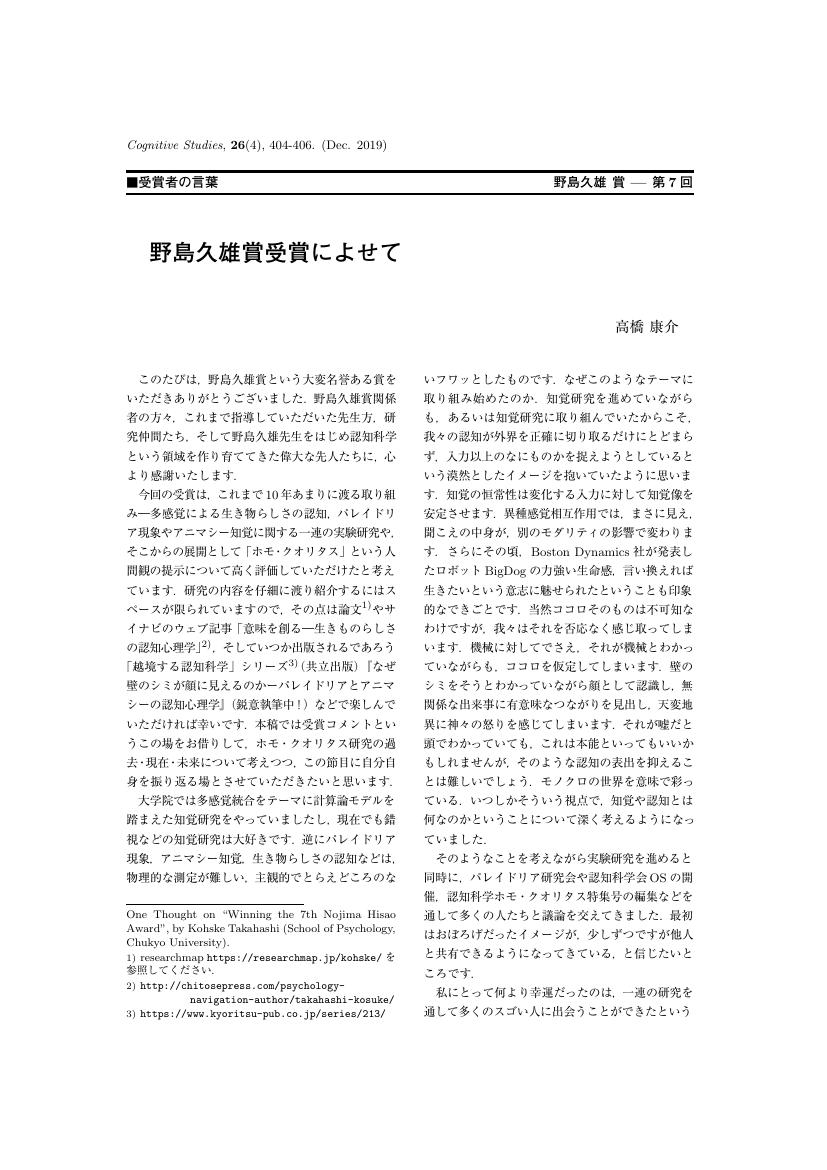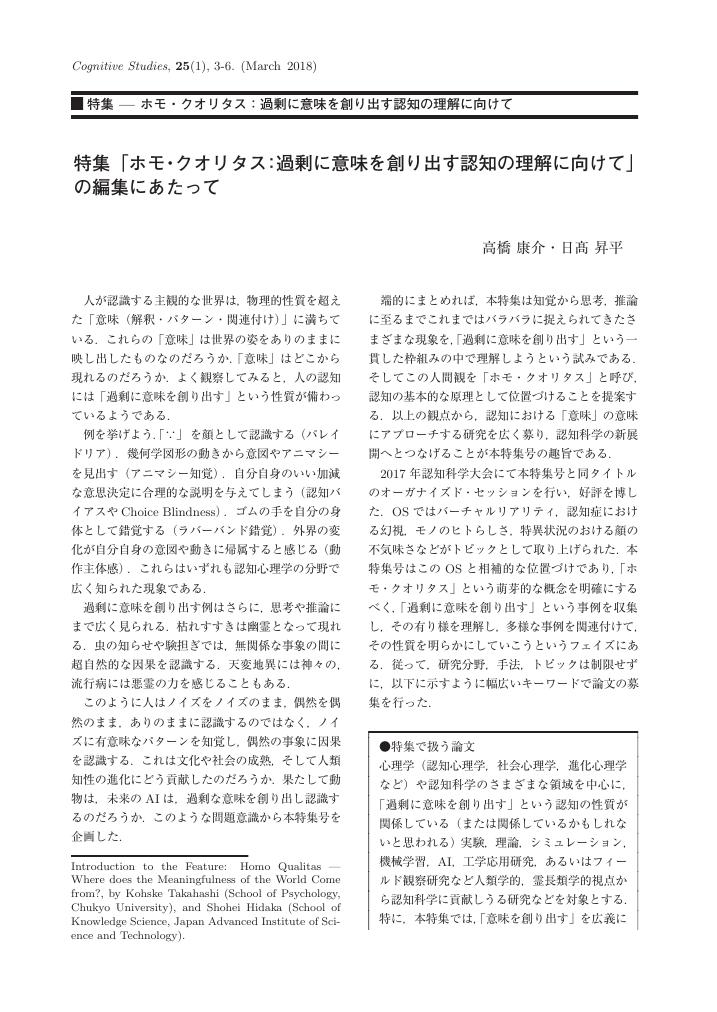53 0 0 0 OA 実証的研究の事前登録の現状と実践 ──OSF事前登録チュートリアル──
- 著者
- 長谷川 龍樹 多田 奏恵 米満 文哉 池田 鮎美 山田 祐樹 高橋 康介 近藤 洋史
- 出版者
- 公益社団法人 日本心理学会
- 雑誌
- 心理学研究 (ISSN:00215236)
- 巻号頁・発行日
- pp.92.20217, (Released:2021-05-31)
- 参考文献数
- 20
- 被引用文献数
- 3 4
In the midst of the current reproducibility crisis in psychology, pre-registration is considered a remedy to increase the reliability of psychological research. However, because pre-registration is an unconventional practice for most psychological researchers, they find it difficult to introduce pre-registration into their studies. To promote pre-registration, this article provides a detailed and practical step-by-step tutorial for beginners on pre-registration with Open Science Framework. Furthermore, a typical example what beginners might experience and ways to resolve such issues are provided as supplementary material. Finally, we discuss various issues related to pre-registration, such as transparent research, registered reports, preprints, and open science education. We hope that this article will contribute to the improvement of reproducible psychological science in Japan.
24 0 0 0 OA 野島久雄賞受賞によせて
- 著者
- 高橋 康介
- 出版者
- 日本認知科学会
- 雑誌
- 認知科学 (ISSN:13417924)
- 巻号頁・発行日
- vol.26, no.4, pp.404-406, 2019-12-01 (Released:2020-03-01)
24 0 0 0 OA 錯視と圏論
- 著者
- 高橋 康介
- 出版者
- 日本認知科学会
- 雑誌
- 認知科学 (ISSN:13417924)
- 巻号頁・発行日
- vol.26, no.4, pp.482-486, 2019-12-01 (Released:2020-03-01)
- 参考文献数
- 4
Tsuchiya & Saigo (2019) proposed the idea that the category theory is the powerful tool for scientific approach towards the mystery of consciousness. Perception, illusion,and consciousness are closely related, and so they also analyzed how to understand the phenomena in some types of visual illusion in terms of the category theory. In this commentary, I discuss about some perceptual phenomena and their theories, such as visual illusion, perceptual constancy, bistable figures, and ill-posed problem of perception, and the limitation of the current theory. Although the power of category theory in the cognitive science is still unclear, I also discuss the potential of category theory to understand illusion and perception from different viewpoint than the existing theories.
- 著者
- 西郷 甲矢人 日髙 昇平 高橋 康介 布山 美慕
- 出版者
- 日本認知科学会
- 雑誌
- 認知科学 (ISSN:13417924)
- 巻号頁・発行日
- vol.28, no.1, pp.70-83, 2021-03-01 (Released:2021-03-15)
- 参考文献数
- 16
- 被引用文献数
- 2
The aim of this article is to provide references to cognitive scientists, who are interested in learning category theory and using it in their research. This article consists of the three sections, question-and-answers on category theory, utility of category theory on cognitive science, and tutorial materials. In the question-and-answers on category theory, we answered to questions, with which beginners of category theory may come up. In the utility of category theory on cognitive science, we raised the three items of utility of category theory in building cognitive models. The learning materials share the books, slides, and videos on the web, recommended to start with.
11 0 0 0 心理統計教育の標準カリキュラム・シラバスはいかにあるべきか(2)
9 0 0 0 OA 気軽に始めるサイコミュ ~TODA RADIOの実際~
- 著者
- 高橋 康介 池田 功毅
- 雑誌
- 中京大学心理学研究科・心理学部紀要 = Chukyo University Bulletin of Psychology
- 巻号頁・発行日
- vol.18, no.1, pp.55-59, 2019-03-15
5 0 0 0 OA 実証的研究の事前登録の現状と実践 ──OSF事前登録チュートリアル──
- 著者
- 長谷川 龍樹 多田 奏恵 米満 文哉 池田 鮎美 山田 祐樹 高橋 康介 近藤 洋史
- 出版者
- 公益社団法人 日本心理学会
- 雑誌
- 心理学研究 (ISSN:00215236)
- 巻号頁・発行日
- vol.92, no.3, pp.188-196, 2021 (Released:2021-08-25)
- 参考文献数
- 20
- 被引用文献数
- 1 4
In the midst of the current reproducibility crisis in psychology, pre-registration is considered a remedy to increase the reliability of psychological research. However, because pre-registration is an unconventional practice for most psychological researchers, they find it difficult to introduce pre-registration into their studies. To promote pre-registration, this article provides a detailed and practical step-by-step tutorial for beginners on pre-registration with Open Science Framework. Furthermore, a typical example what beginners might experience and ways to resolve such issues are provided as supplementary material. Finally, we discuss various issues related to pre-registration, such as transparent research, registered reports, preprints, and open science education. We hope that this article will contribute to the improvement of reproducible psychological science in Japan.
4 0 0 0 心理統計教育の標準カリキュラム・シラバスはいかにあるべきか
本研究では知覚像が従来考えられているよりも自由に制御できる可能性について実証研究を進める。構造化を抑制して未統合の感覚信号にアクセスし高感度の知覚像を得る脱構造化現象と、心的イメージと知覚像を合成する信念可視化現象という2種類の知覚像制御過程の解明を目指す。前半は熟達者を対象とした知覚心理学・脳科学研究により知覚像制御の現象理解、心的過程と神経基盤の解明、予測符号化の枠組みでの理論化を行う。後半は非熟達者を対象に知覚像制御の熟達過程や個人差・適性を検討する。以上の研究を通して「不自由でままならぬ」という従来の知覚観から脱却し、ある程度まで自由に制御できる知覚像という新しい知覚観を提案する。
2 0 0 0 脳内盤の表象と多様性に関する心理学的研究
- 著者
- 高橋 康介
- 出版者
- 立命館大学
- 雑誌
- 学術変革領域研究(A)
- 巻号頁・発行日
- 2022-06-16
棋士は脳内に将棋盤をイメージし操作する(以降「脳内盤」と呼ぶ)。熟達した棋士の脳内盤の在り方は多様であり、将棋に関する法則と物語が内在化されている。本研究では棋士の中にある熟達した脳内盤の表象と多様性を明らかにし、その多様性を生み出す背景要因を探る。まず脳内盤メトリクスを作成し、オンライン調査により棋士の脳内盤の表象と多様性を定量的かつ体系的に解明する(研究1)。続いて棋士のイメージ化に関連する認知特性の個人差を認知心理学実験により検討する(研究2)。さらにインタビュー調査により棋士それぞれの固有の脳内盤が育まれた熟達化過程、来歴、経験を探る(研究3)。
1 0 0 0 OA 連続提示顔の変形効果に影響する顔部位の検討
- 著者
- 鈴木 萌々香 氏家 悠太 高橋 康介
- 出版者
- 日本認知心理学会
- 雑誌
- 日本認知心理学会発表論文集 日本認知心理学会第19回大会
- 巻号頁・発行日
- pp.15, 2022 (Released:2022-04-20)
複数の顔写真を周辺視野に次々に提示すると不気味さや歪みを感じる(FFDE)。本研究ではFFDE刺激として顔全体提示、上半分提示、目のみ提示、目非提示、輪郭非提示の5条件を用いて、顔の各部位がFFDEの強さに及ぼす影響を検討した。実験では250 msごとに写真を切り替えながらFFDE刺激を10秒間提示し、刺激観察中に歪み知覚が生じたらボタンを押すこと、刺激提示後に歪みと不気味さの主観的強度を7段階で回答することを求めた。実験の結果、提示する顔部位により歪みや不気味さの主観的強度が異なり、顔全体>輪郭非提示>上半分>目非提示>目のみ提示の順となった。また刺激観察中に歪みを知覚するまでの潜時も提示する顔部位により異なっていたが、主観的強度の順序とは乖離が見られた。以上の結果から顔の全体処理がFFDEの生起に関与すること、またFFDEの強度と潜時には異なる決定要因が存在することが示唆された。
1 0 0 0 ネッカーキューブはなぜあの立体にみえるのか
- 著者
- 日髙 昇平 高橋 康介
- 出版者
- 日本認知科学会
- 雑誌
- 認知科学 (ISSN:13417924)
- 巻号頁・発行日
- vol.28, no.1, pp.25-38, 2021
<p>Visual perception, receiving a two-dimensional (2D) visual input, often constructs the three-dimensional (3D) perceptual image. Although there are generally multiple structures in the external world that give an equivalent two-dimensional retinal image, the perceptual process naturally and easily infers only one 3D structure as the solution. However, the following problems are not obvious at all: what kind of structure can be obtained as a 3D perceptual image from certain 2D information, and why do we get a three-dimensional perceptual image instead of a two-dimensional one. In the present study, we investigate this problem by untangling the Necker Cube phenomenon, and propose a novel theory of three-dimensional visual perception from the viewpoint of the efficiency of information coding. Among the possible structures that can yield the 2D retinal image of the Necker Cube, the structure of the typical three-dimensional perceptual image of the Necker Cube maximizes the symmetry (in group theory). This maximization of symmetry is characterized by the pairs of adjoint functors (in category theory). Therefore, according to this proposed theory, "the Necker Cube" in the three-dimensional space is perceived as the most efficient encoding of the two-dimensional retinal image.</p>
- 著者
- 西郷 甲矢人 日髙 昇平 高橋 康介 布山 美慕
- 出版者
- 日本認知科学会
- 雑誌
- 認知科学 (ISSN:13417924)
- 巻号頁・発行日
- vol.28, no.1, pp.70-83, 2021
<p>The aim of this article is to provide references to cognitive scientists, who are interested in learning category theory and using it in their research. This article consists of the three sections, question-and-answers on category theory, utility of category theory on cognitive science, and tutorial materials. In the question-and-answers on category theory, we answered to questions, with which beginners of category theory may come up. In the utility of category theory on cognitive science, we raised the three items of utility of category theory in building cognitive models. The learning materials share the books, slides, and videos on the web, recommended to start with.</p>
1 0 0 0 OA ダイバーシティについて考える
1 0 0 0 OA 変動する世界と適応する私たちのために
- 著者
- 高橋 康介
- 出版者
- 中京大学心理学研究科・心理学部
- 雑誌
- 中京大学心理学研究科・心理学部紀要 = Chukyo University Bulletin of Psychology (ISSN:13488929)
- 巻号頁・発行日
- vol.20, no.1, pp.23, 2021-03-15
1 0 0 0 OA 特集「ホモ・クオリタス:過剰に意味を創り出す認知の理解に向けて」の編集にあたって
1 0 0 0 OA 対人接触行動の感性情報とその因子空間
- 著者
- 高橋 康介 三橋 秀男 村田 一仁 則枝 真 渡邊 克巳
- 出版者
- Japan Society of Kansei Engineering
- 雑誌
- 日本感性工学会論文誌 (ISSN:18845258)
- 巻号頁・発行日
- vol.10, no.2, pp.261-268, 2011 (Released:2011-12-09)
- 参考文献数
- 15
- 被引用文献数
- 1
Nonverbal communications involving physical contact convey “Kansei” information that is difficult to express in verbal communications. In this study, we proposed a method to investigate “Kansei” information in nonverbal communications, and surveyed how people perceive nonverbal communication involving physical contact. In the psychological experiment using questionnaire, we presented various words describing tapping and patting actions with Japanese onomatopoeias and sound symbolic words expressing a concept or nuance that is difficult to verbalize explicitly. Participants first imaged the situation wherein they made communication with another person through the physical contact, and then evaluated the “Kansei” information of communications and rated them by adjectives. We found that onomatopoeias added a variety of impressions to communications with physical contact. We then applied factor analysis using adjective rating to extract a factor space of the communicative actions. For both tapping and patting motion, the first factor represented atmosphere of the behavior, and the second dimension represented activeness of the physical motions themselves. We then mapped the rating scores of desirability of the communication onto the factor spaces. The scores of the first and the second factors well predict in an additive way the desirability of communication for both actions, and the influence of the first factor was stronger than that of the second factor. These results suggest that the structure of factor space represents desirability of the communication regardless of actions. The proposed method may be useful and efficient to investigate the Kansei information, factor space, and their inter-relation, of nonverbal communications.
- 著者
- 高橋 康介
- 出版者
- 東京大学
- 雑誌
- 研究活動スタート支援
- 巻号頁・発行日
- 2012-08-31
本研究は可視化データ認知におけるバイアスの発生機序の解明、及びバイアス除去のための学習法の確立を目指し、以下の3 つのテーマについて実験研究を行うものである。(1)グラフ理解課題時の眼球運動測定を行い、視線パターンのダイナミクスを同定する。(2)高次データ変換法を用いた認知課題により、グラフ理解におけるノービスとエキスパートの認知モデルを明らかにする。(3)可視化データ認知におけるバイアス除去のための学習法を開発し、効果を検証する。初年度は当初計画通り(2)の高次データ変換法を用いた認知実験を行った。高次データ変換法とは3次元以上からなるデータに対して部分次元の関係を複数のグラフで呈示し、それらを統合することで高次元データの把握を求めるという新規な手法である。予備的実験として当初予定の実験内容(グラフ作成課題)を実施した結果、課題難易度が非常に高く、エキスパートの被験者にとっても課題遂行が困難であった。このため実験課題を一部変更し、部分的に情報が欠落したグラフを完成させる課題に変更した。課題変更の結果、ノービスの被験者であっても課題を遂行できる程度の難易度に調整することが可能であった。実験の結果、試行を重ねるにつれて課題遂行時間や正答率において向上が認められた。また呈示する部分グラフ次元の空間関係による効果も認められた。今後、学習進行に応じたバイアスの減少等の詳細な分析を行う予定である。
1 0 0 0 無意識的な手の動きにおける2者間の同期(手)
- 著者
- 高橋 康介 渡邊 克巳
- 出版者
- 一般社団法人電子情報通信学会
- 雑誌
- 電子情報通信学会技術研究報告. HIP, ヒューマン情報処理 (ISSN:09135685)
- 巻号頁・発行日
- vol.108, no.282, pp.111-116, 2008-10-31
- 被引用文献数
- 2
ヒトの運動は、それが完全に自発的なものであっても、少なからず他者の影響を受ける。例えば足踏みやタッピング動作を行うときに、目の前の他者も同様の動作を行っていると、二人の動作のリズムやタイミングは同期する。一方、身体を静止させておくというように意図的な運動を行わない状況であっても、人の身体には無意識的かつ微少な動きが生じ、風景の動きなどの視覚情報はこれらの動きに潜在的に影響を及ぼすことが知られている。自発的な動作の同期と同様に、他者の視覚情報が無意識的な動きに与える潜在的な影響を調べることは、対人コミュニケーションの基礎となるメカニズムを解明する手掛かりになると考えられる。そこで本研究では他者の情報が無意識的な身体の動きに与える影響を検討した。実験では二人の人が対面して座り、相手の指を見ながら、自分の指で相手を指さし静止させるという課題を行い、静止動作中の指の微小な動きを測定した。その結果、水平方向の指の動きに関して他者の影響が認められ、2者間の同期を反映した指標を同定することに成功した。さらに意識的に相手の指の動きに追従するという他者とのインタラクションを経験することで、これらの同期指標が上昇した。以上の結果から、意識的な運動生成に限らず無意識的で微少な身体動作に対しても他者の情報が潜在的に影響を与えること、また他者とのインタラクションの経験により、他者の情報の影響が強まることが示された。
- 著者
- 高橋 康介 三橋 秀男 則枝 真 仙洞田 充 村田 一仁 渡邊 克巳
- 出版者
- 一般社団法人電子情報通信学会
- 雑誌
- 電子情報通信学会技術研究報告. HCS, ヒューマンコミュニケーション基礎 (ISSN:09135685)
- 巻号頁・発行日
- vol.109, no.224, pp.11-16, 2009-10-01
非言語コミュニケーションは、言語による伝達が出来ないような情報を伝える。本研究ではオノマトペを用いて、接触行動を伴う非言語コミュニケーションがどのように感じられているのかを調べた。実験では二人の人物の接触行動を伴うコミュニケーションが描かれた写真を呈示し、適切なオノマトペなど、一連の質問項目に答えた。その結果、雰囲気を表すようなオノマトペで表現されたコミュニケーションは比較的望まれるものであったのに対し、動作の特性を表すようなオノマトペで表現されたコミュニケーションは「行いたい」と感じられなかった。またコミュニケーションに対する形容詞評定を用いて主成分分析を行った結果、第一主成分として場の雰囲気(暖かさ)を表す軸が、第二主成分として動作の特性を表す軸が現れた。以上の結果から、接触行動を伴うコミュニケーションにおいては動作の特性自体よりもそのコミュニケーションにより生じる雰囲気の方が優先的に受け取られ、また望ましさを決定することが示唆された。

